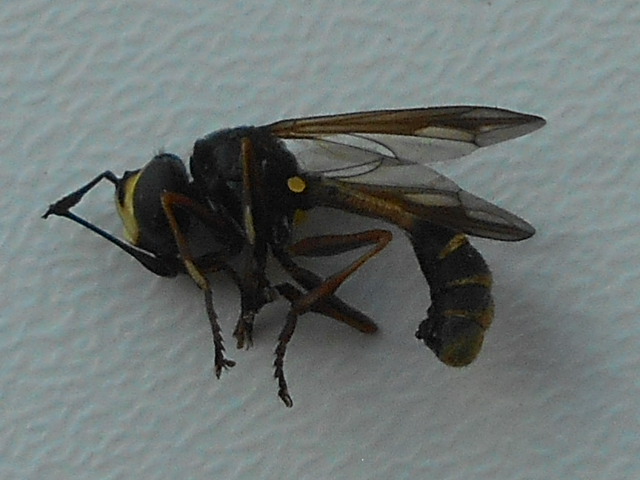As it happens I never made it as far as the lake.
I entered the Country Park, not via the main car park, but from the south west corner and was immediately confronted by a lovely little patch of rough ground with a fine display of wild flowers. There were insects to be seen everywhere. A Six-spot Burnet Moth, Zygaena filipendulae, was busy at a thistle head and was still there three quarters of an hour later. Each thistle head consists of a hundred or so florets so I suppose when the moth had got to the last one it could start again at number one!
 |
A Six-spot Burnet feeds at Creeping Thistle. Daventry Country Park.
14 July, 2017
|
The burnet moths resemble butterflies in being diurnal fliers and were, it seems, a puzzle to early entomologists, who seemed to regard them as half-way between moths and butterflies.
In my blog a couple of days ago I was scratching my head over a footman moth and today I found myself with the same problem. However I am confident that today's specimen was a Common Footman, Eilema lurideola.
 |
A Common Footman dropped into my upturned umbrella.
Daventry Country Park. 14 July, 2017
|
Coloration, wing-shape and the form of the yellow wing margin lead me to this conclusion - plus the fact that this species is ubiquitous.
An experienced lepidopterist would probably have little hesitation in naming this skipper but when it comes to these insects I admit to being a tyro. However, there is no sign of a black tip to the antennae so I am reasonably certain that it is a female Small Skipper, Thymelicus flavus, here on a head of yarrow.
 |
A Small Skipper on Yarrow at Daventry Country Park.
14 July, 2017
|
Plenty of Bumblebees were around and so too was one of their major enemies, the conopid fly Physocephala rufipes.
 |
| Physocephala rufipes, taken at Daventry Country Park. 14 July, 2017 |
This odd-looking insect is parasitic on a range of bumblebee species, seizing a victim and laying its eggs directly on to the abdomen of the unfortunate host. In his booklet on the species Kenneth Smith writes: '...females wait on nearby vegetation and attack foraging bees with a very quick strike when both bee and fly may roll on the ground together in a violent struggle'. Some conopid bee species in the U.S.A. attack hive bees and may cause significant losses. The usual conopid fly I see is the very wasp-like Conops quadrifasciatus so this was an interesting record. (There is a very good photograph of this fly on page 315 of Peter Marren and Richard Mabey's 2010 book Bugs Britannica but I believe the caption may be wrong.)
I didn't spend all my time looking at insects and, strolling around the area, I found that some leaves on Alder, Alnus glutinosa, had been seriously disfigured by galls.
I didn't spend all my time looking at insects and, strolling around the area, I found that some leaves on Alder, Alnus glutinosa, had been seriously disfigured by galls.
 |
Leaves of alder were disfigured with the galls of a mite,
Eriophyes laevis. Daventry Country Park. 14 July, 2017
|
The culprit was a mite, Eriophyes laevis. This is widespread in the south and midlands of England. Does it attack the widely-planted Grey Alder? I'm not sure: I'll keep my eyes open.
No comments:
Post a Comment